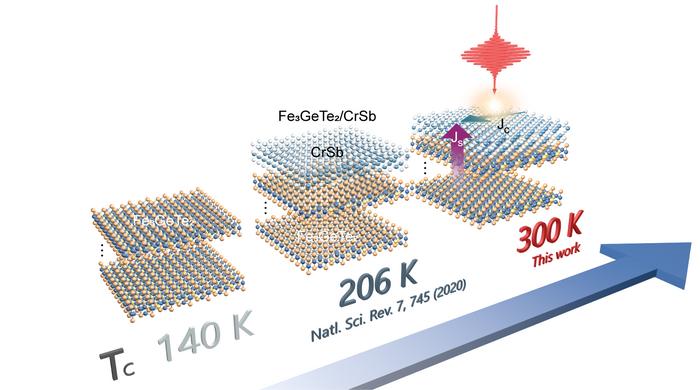
In recent years, the quest for advanced materials capable of sustaining ultrafast spin currents has gained significant momentum, driven by the overwhelming demand for rapid data processing and high-density information storage. Within this enabling research domain, intrinsic magnetic materials, particularly those formed in two-dimensional structures, have emerged as front-runners. These materials not only allow for remarkable control over electron spins but also serve as a fertile ground for exploring femtosecond-scale spin dynamics. The limitations posed by diminishing Curie temperatures, however, have necessitated innovative solutions.
A collaborative research initiative, spearheaded by leading physicists including Prof. Dr. Xiaojun Wu from Beihang University and several esteemed colleagues from the Institute of Physics at the Chinese Academy of Sciences as well as Fudan University, has unveiled the capacity of (Fe3GeTe2/CrSb)3 superlattice to enhance the Curie temperature significantly. Their research reveals that when carefully manipulated, this stacking arrangement creates conditions conducive for effective ultrafast spin current generation, even at room temperature. This overcomes the conventional barriers imposed upon the practical application of van der Waals magnets without compromising their intrinsic properties.
The pivotal takeaway from this study revolves around the dual operational mechanisms governing spin current generation across various thermal regimes. Below the Curie temperature, the research team discovered that spin currents are predominantly induced through ultrafast demagnetization processes present in the ferromagnetic phase. These phenomena are triggered by short-duration femtosecond optical laser pulses, making them radically different from the processes that govern behavior above the Curie point. Here, in stark contrast, a novel laser-enhanced proximity effect comes into play, setting up intricate interactions between the constituent layers of the superlattice.
Delving deeper into the underlying physical processes, the team employed comprehensive theoretical simulations to validate their experimental observations. Upon subjecting the superlattice to photoexcitation, researchers noted an impressive interlayer displacement, with values reaching up to 1 Å between the Fe3GeTe2 and CrSb layers. This minute yet consequential gap alteration led to an enhancement in electron-electron exchange interactions taking place at the critical interface between the two layers. The amplification of these interactions remains a key contributor to the abnormal spin dynamics observed in the superlattice, making the generation of spin currents feasible even above the established Curie temperature.
Prof. Dr. Xiaojun Wu emphasized the counterintuitive nature of these findings, stating that the emission of spintronic terahertz radiation from the (Fe3GeTe2/CrSb)3 structure at room temperature was unexpected due to the perceived absence of ferromagnetic order beyond the 206 K threshold. Yet, the influence of femtosecond optical pulses was profound, enabling the excitation of spin polarization in a non-equilibrium condition—an outcome that allows for the rapid generation of spin currents.
Ultimately, the research team meticulously prosecuted the trajectory of events activated by photoexcitation, laying out a comprehensive timeline. Initial absorption of the 800-nm pump laser by the superlattice triggers a rapid contraction of the interlayer distance, which occurs in the timescale of mere hundreds of femtoseconds. This swift alteration in distance substantially amplifies the previously mentioned proximity effect, resulting in a fortified interaction that provokes notable levels of spin polarization in the Fe3GeTe2 layer, even surpassing the Curie temperature. As a simultaneous result, the magnetic moment of the CrSb layer transitioned from an out-of-plane orientation to an in-plane alignment, facilitating a reorientation of the spins in Fe3GeTe2 to correlate with this new magnetic landscape.
Given that the photon energy of the pump laser exceeds the optical gaps present in both FGT and CrSb materials, this aspect further initiates the excitation of photocarriers. These carriers are polarized along the in-plane direction, thereby generating a spin-polarized current that seamlessly injects into the CrSb layer. This current is subsequently converted into a charge current via the spin-to-charge conversion effect, ultimately culminating in the emission of terahertz radiation.
The implications of these findings extend far beyond academic interest; they present a transformative pathway for producing ultrafast spin currents without the necessity of magnetic elements, thus highlighting the pioneering role that laser terahertz emission spectroscopy may play in probing ultrafast spin dynamics induced by laser interactions. The groundbreaking nature of this research sets the stage for further innovations across various domains, particularly those focused on utilizing two-dimensional materials for spintronic applications.
As the global scientific community converges on harnessing these ultrafast spin currents and developing efficient technologies that rely on this principle, the findings of the (Fe3GeTe2/CrSb)3 superlattice redefine contemporary paradigms. This exploration of laser-induced exceptional spin dynamics resonates strongly with the ongoing narrative of redefining the boundaries of data storage and processing speeds.
The study illustrates a clear leap forward in understanding how two-dimensional materials can be manipulated to achieve extraordinary control over spin currents, driving the field of spintronics into a new era filled with potential and promise.
Subject of Research: Ultrafast Spin Current Generation in Superlattices
Article Title: Above Curie Temperature Ultrafast Terahertz Emission and Spin Current Generation in a Two-Dimensional Superlattice (Fe3GeTe2/CrSb)3
News Publication Date: October 2023
Web References: DOI: 10.1093/nsr/nwae447
References: National Science Review
Image Credits: ©Science China Press
Keywords
Ultrafast spin currents, two-dimensional materials, Fe3GeTe2, CrSb, Curie temperature, femtosecond laser pulses, spintronic applications.





